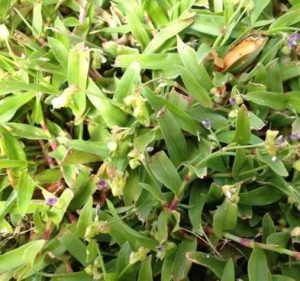Doveweed is an aggressive summer annual weed. It rapidly invades warm-season turfgrass species, especially in residential lawns, and few herbicides can effectively control it. Because of these challenges, a well-designed management strategy is necessary for doveweed control.
Identifying doveweed can be difficult because this weed looks like grass and has a leaf width similar to St. Augustinegrass. Unless one takes a closer look, doveweed can go unnoticed when growing among turfgrass. Doveweed leaves are lanceolated, thick with a shiny, rubbery texture, and attached to creeping stems (stolons) that can produce roots from their nodes. This characteristic allows doveweed to be vegetatively propagated (i.e., spread without seeds); thus, mowers can spread pieces of stolons and disperse this weed even before its seed is produced. Doveweed flowers have three clearly visible purple (sometimes blue) petals, and the fruit is a spherical capsule that usually has three seeds. The seeds can be dispersed by mowers and also by moving water.
Doveweed seeds start germinating late in the spring, when soil temperatures reach 65°–70°F. Therefore, seedling emergence will occur when the effect of preemergence (PRE) herbicides applied earlier in the spring (e.g., February or March) for crabgrass and goosegrass may be fading out, thus increasing the chances for escapes (i.e., weed emergence after herbicide treatment).
 Doveweed prefers wet areas, so drainage issues or overwatering will favor the establishment and growth of this weed. These conditions also limit turf growth, creating the perfect conditions for the displacement of the turf by this weed. Reducing wet conditions and avoiding overwatering are two effective ways to manage doveweed. After doveweed plants are established, they will grow vigorously during summer because they are well adapted to warm environments. Their growth will start to slow when temperatures fall below 70°F, and this is usually the time when seeds are produced.
Doveweed prefers wet areas, so drainage issues or overwatering will favor the establishment and growth of this weed. These conditions also limit turf growth, creating the perfect conditions for the displacement of the turf by this weed. Reducing wet conditions and avoiding overwatering are two effective ways to manage doveweed. After doveweed plants are established, they will grow vigorously during summer because they are well adapted to warm environments. Their growth will start to slow when temperatures fall below 70°F, and this is usually the time when seeds are produced.
The best control against doveweed is a strong PRE herbicide program. Several PRE herbicides provide the highest levels of control if applied at the right time. For St. Augustinegrass, more PRE than postemergence (POST) herbicides can be used safely without causing turf injury. Herbicide recommenrations can be found here: http://edis.ifas.ufl.edu/ag395
It is difficult to completely eliminate a doveweed problem in a single year, especially when the populations of this weed are high. Doveweed seeds can survive in the soil for several years, so doveweed management should be planned for two or three years. For these reasons, a set of sequential, complementary actions, including turf management practices and herbicide applications, are the best strategy. It is important to combine sequences of PRE and POST herbicide applications such that the herbicide is active when the doveweed is most susceptible (early growth stages); following applications will kill the surviving plants. Finally, once herbicides have taken effect, a healthy, aggressive turfgrass is the best defense against doveweed.
More info here: http://hort.ifas.ufl.edu/woody/Pages/acerub/acerub.shtml/
 2
2

